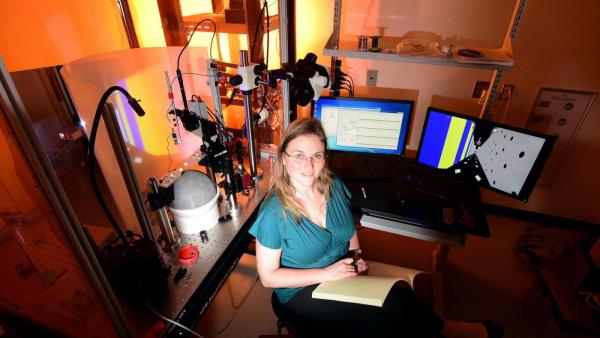If you keep up with medical news, you’ve probably heard of beta amyloid. It plays the villain in plenty of stories about Alzheimer’s disease: One of the signature markers of Alzheimer’s patients is plaque buildup created by the protein.
Researchers know that much. The problem is, underlying causes of memory problems in Alzheimer’s disease are still poorly understood.
Annabelle Singer, assistant professor in the Wallace H. Coulter Department of Biomedical Engineering and a researcher in the Petit Institute for Bioengineering and Bioscience, is trying to change that. Through studying brain activity in mice genetically programmed to get Alzheimer’s, she hopes to help chart earlier signals of disease – and maybe even engineer ways to prevent or reverse it.
Instead of jumping right to plaque, her Alzheimer’s research focuses on brain activity before plaque forms.
“If we understand these patterns of neural activity that predict behavior and memory deficits,” said Singer, who began in the Coulter Department in mid-2016. "Then we can use these as a marker for the disease.”
That’s a big ambition, but for now, its setting is relatively modest. Singer and members of her lab work in a space equipped with computers, neural-recording devices and a curved screen. They train mice to navigate a virtual-reality maze (which looks a little like a 1980s video game) projected on the screen, and then they record brain activity as the mice respond to challenges and rewards they find there.
The idea is to track deficits in neural activity, because they can have sharp impacts on behavior. If doctors and scientists can change patterns in this activity early on, Singer reasons, there might be a chance to prevent Alzheimer’s altogether.
She’s already made significant strides in her research. Working with Hannah Iaccarino, a graduate student in Professor Li-Huei Tsai’s lab at the Massachusetts Institute of Technology, she published an article in Nature. Its central study, which focused on mice with early signs of Alzheimer’s, revealed huge potential for driving brain waves as an Alzheimer’s disease treatment. Surprisingly, they could drive these therapeutic brain waves with a simple flickering light, like a strobe light but faster.
Under the right conditions, the lighting could do more than just impact brain waves; it could actually redirect them to help clear beta amyloid plaque. Eventually, Singer would like to see similar kinds of noninvasive treatments – light therapy that can change patterns in brain activity, for example – tested on people.
But for now, there’s a lot more work to go with mice. Singer, who received her Ph.D. from the University of California, San Francisco, saw Georgia Tech could offer the kind of interdisciplinary atmosphere her research requires.
“I wanted to go to a place that did excellent neuroscience and excellent engineering,” she said, “and I wanted to know that there would be students who were comfortable with both sides of it.”
In her lab, she’s taken on students with backgrounds in both areas, and Emory University’s joint stake in the Coulter Department means Singer has access to its Alzheimer’s Disease Research Center. She also appreciates the supportive atmosphere among Tech faculty members.
“I feel like people are rooting for me as a young faculty member, regardless of whether or not it helps them, and that’s nice,” she said.
Singer was always interested in psychology. In graduate school, she got involved with the UCSF Memory and Aging Center, where patients were tested for memory problems and thinking issues. What really interested her, though, was how to bridge that kind of work with what she was already doing. Her own research centered on neurons and the ways they work together to create new memories, and she wanted to link that research with the wider world of human brain function.
Later, during her postdoctoral years, she saw she could explore her interests in “understanding Alzheimer’s disease at what we call the circuit or system level.” That is to say, she wanted to learn more about how a brain’s neurons might misfire long before an Alzheimer’s diagnosis.
Singer knows the stakes are high. Though her current work is concentrated on mice in the lab, she’s always conscious of its implications on human life.
“We think about our lives, ourselves, in terms of stories,” she said. “I am who I am because of the things I’ve done and the experiences I’ve had. If you lose that, it’s like you lose yourself.”
Still, Singer thinks some of Alzheimer’s most devastating realities might also signal hope for new treatments. She noted that patients don’t experience “a steady decline in cognitive function, so it’s not like every day you get a little worse. Instead, patients can shift between seeming pretty normal and seeming pretty lost and disoriented, even in the same day.”
“That kind of spontaneous shift from highly functional to dysfunctional – that's not cell death,” she explained. “Those are reversible things in the brain. If we can figure out what's going on there, that's a potential route to a therapy.”
Story by Lyndsey Lewis
Media Contact
Walter Rich
Keywords
Latest BME News
Jo honored for his impact on science and mentorship
The department rises to the top in biomedical engineering programs for undergraduate education.
Commercialization program in Coulter BME announces project teams who will receive support to get their research to market.
Courses in the Wallace H. Coulter Department of Biomedical Engineering are being reformatted to incorporate AI and machine learning so students are prepared for a data-driven biotech sector.
Influenced by her mother's journey in engineering, Sriya Surapaneni hopes to inspire other young women in the field.
Coulter BME Professor Earns Tenure, Eyes Future of Innovation in Health and Medicine
The grant will fund the development of cutting-edge technology that could detect colorectal cancer through a simple breath test
The surgical support device landed Coulter BME its 4th consecutive win for the College of Engineering competition.








